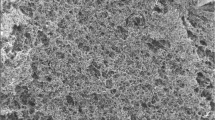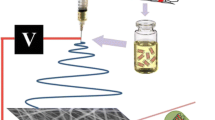Abstract
The local delivery of chemotherapy drugs using implantable drug delivery systems is a promising strategy to the treatment of malignant brain tumors. In this study, core/shell chitosan-poly ethylene oxide-carbon quantum dots/carboxymethyl cellulose-polyvinyl alcohol (CS-PEO-CQDs/CMC-PVA) nanofibers were successfully prepared through coaxial electrospinning as a biodegradable polymeric implant for the local delivery of temozolomide (TMZ). Fluorescent carbon dots with carboxyl-rich surface were used as a trackable drug delivery agent for the localized cancer treatment. The effects of several preparation parameters such as voltage, shell to core flow rate, CS/PEO ratio, and PVA/CMC ratio on the structure of nanofibers were investigated. The best nanofibers were obtained in the condition of CS/PEO ratio of 80:20, CMC/PVA ratio of 20:80, shell to core flow rate of 3, and voltage of 25 V. SEM images showed that such nanofibers possess a smooth surface and bead-less structures. The results obtained by DSC indicated that TMZ trapped in the nanofibers existed in an amorphous or disordered crystalline status. In vitro release profile of TMZ from core-shell nanofibers had biphasic patterns. After an initial burst, a continuous drug release was observed for up to 28 days. The in vitro antitumor activity of CQDs-TMZ was tested against the tumor U251 cell lines than the free drug. It has been found that the cytotoxicity of TMZ to U251 cancer cells is enhanced when TMZ is conjugated with CQDs.






Similar content being viewed by others
References
Zhang H, Gao S. Temozolomide/PLGA microparticles and antitumor activity against glioma C6 cancer cells in vitro. Int J Pharm. 2007;329:122–8.
Thirupathy A, Srinivas P, Babu D, Mamidi S. Formulation and evaluation of sustained release implantable microspheres of temozolomide for brain targeting prepared by a novel technique. Int J Pharm Pharm Sci. 2011;3:187–94.
Tanaka S, Louis DN, Curry WT, Batchelor TT, Dietrich J. Diagnostic and therapeutic avenues for glioblastoma: no longer a dead end? Nat Rev Clin Oncol. 2013;10:14–26.
Sivakumar H, Strowd R, Skardal A. Exploration of dynamic elastic modulus changes on glioblastoma cell populations with aberrant EGFR expression as a potential therapeutic intervention using a tunable hyaluronic acid hydrogel platform. Gels. 2017;3:28.
Drappatz J, Norden AD, Wong ET, Doherty LM, LaFrankie DC, Ciampa A, et al. Phase I study of vandetanib with radiotherapy and temozolomide for newly diagnosed glioblastoma. Int J Radiat Oncol Biol Phys. 2010;78:85–90.
Weller M, Van den Bent M, Hopkins K, Tonn JC, Stupp FA, Moyal ECJ, et al. Task force on malignant glioma. EANO guideline for the diagnosis and treatment of anaplastic gliomas and glioblastoma. Lancet Oncol. 2014;15:e395–403.
Azizi SA, Miyamoto C. Principles of treatment of malignant gliomas in adults: an overview. J Neuro-Oncol. 1998;4:204–16.
Martinho O, Vilaça N, Castro PJ, Amorim R, Fonseca AM, Baltazar F, et al. In vitro and in vivo studies of temozolomide loading in zeolite structures as drug delivery systems for glioblastoma. RSC Adv. 2015;5:28219–27.
Diez BD, Statkevich P, Zhu Y, Abutarif MA, Xuan F, Kantesaria B, et al. Evaluation of the exposure equivalence of oral versus intravenous temozolomide. Cancer ChemothPharmacol. 2010;65:727–34.
Agarwala SS, Kirkwood JM. Temozolomide, a novel alkylating agent with activity in the central nervous system, may improve the treatment of advanced metastatic melanoma. Oncolog. 2000;5:144–51.
Newlands E, Stevens M, Wedge S, Wheelhouse RT, C Brock C. Temozolomide: a review of its discovery, chemical properties, pre-clinical development and clinical trials. Cancer Treat Rev. 1997;23:35–61.
Talebian S, Foroughi J, Wade SJ, Vine KL, Dolatshahi-Pirouz A, Mehrali M, et al. Biopolymers for antitumor implantable drug delivery systems: recent advances and future outlook. Adv Mater. 2018;30(31):1706665.
Fu Y, Chen X, Mou X, Ren Z, Li X, Han G. A dual-color luminescent localized drug delivery system with ratiometric-monitored doxorubicin release functionalities. ACS Biomater Sci Eng. 2016;2:652–61.
GRd S, Fialho SL, Siqueira RC. Implants as drug delivery devices for the treatment of eye diseases. Braz J Pharmaceut Sci. 2010;46:585–95.
Misra S, Srivastava AK, Raghuwanshi S, Sharma V, Bisen PS. Medical grade biodegradable polymers: a perspective from gram-positive bacteria. Fundament Biomater. 2018:267–86.
Denkbas EB, Ottenbrite RM. Perspectives on: chitosan drug delivery systems based on their geometries. J Bioact Compat Polym. 2006;21(3):351–68.
Salum MR, Lam DTY, Wexner SD, Pikarsky A, Baig MK, Weiss EG, et al. Does limited placement of bioresorbable, membrane of modified sodium hyaluronate and carboxymethylcellulose (seprafilm) have possible short-term beneficial impact? Dis Colon Rectum. 2001;44(5):706–12.
Javanbakht S, Shaabani A. Carboxymethyl cellulose-based oral delivery systems. Int J Biol Macromol. 2019;133:21–9.
Vlachou M, Kikionis S, Siamidi A, Tragou K, Kapoti S, Ioannou E, et al. Curr Drug Deliv. 2019;16:79–85.
Ashraf R, Sofi HS, Malik A, Beigh MA, Hamid R, Sheikh FA. Recent trends in the fabrication of starch nanofibers: electrospinning and non-electrospinning routes and their applications in biotechnology. Appl Biochem Biotechnol. 2019;87:47–74.
Wang W, Jin X, Zhu Y, Chengzhang Z, Yang J, Wang H, et al. Effect of vapor-phase glutaraldehyde crosslinking on electrospun starch fibers. Carbohydr Polym. 2016;140:356–61.
Nguyen TTT, Chung OH, Park JS. Coaxial electrospun poly(lactic acid)/chitosan (core/shell) composite nanofibers and their antibacterial activity. Carbohydr Polym. 2011;86:1799–806.
Najafi-Taher R, Derakhshan MA, Faridi-Majidi R, Amani A. Preparation of an ascorbic acid/PVA–chitosan electrospun mat: a core/shell transdermal delivery system. RSC Adv. 2015;5:50462–9.
Li X, Su Y, Chen R, He C, Wang H, Mo X. Fabrication and properties of core-shell structure P (LLA-CL) nanofibers by coaxial electrospinning. J Appl Polym Sci. 2009;111:564–1570.
Zeng Q, Shao D, He X, Ren Z, Ji W, Shan C, et al. Carbon dots as a trackable drug delivery carrier for localized cancer therapy in vivo. J Mater Chem B. 2016;4:5119–26.
Liao L, Liu J, Dreaden EC. A convergent synthetic platform for single-nanoparticle combination cancer therapy: ratiometric loading and controlled release of cisplatin, doxorubicin, and camptothecin. J Am Chem Soc. 2014;136:5896–9.
Qu S, Liu X, Guo X, Chu M, Zhang L, Shen D. Amplified spontaneous green emission and lasing emission from carbon nanoparticles. Adv Funct Mater. 2014;2:689–2695.
Wang Q, Huang X, Long Y, WangX, Zhang H, Zhu R, Liang L, Teng P, Zheng H. Hollow luminescent carbon dots for drug delivery. Carbon 2013;59:192-199.
Sun Y-P, Zhou B, Lin Y, Wang W, Fernando KAS, Pathak P, et al. Quantum-sized carbon dots for bright and colorful photoluminescence. J Am Chem Soc. 2006;128:7756–7.
Savla R, Taratula O, Garbuzenko O, MinkoT. Tumor targeted quantum dot-mucin 1 aptamer-doxorubicin conjugate for imaging and treatment of cancer. J Control Release 2011;153:16-22.
Barati A, Shamsipur M, Abdollahi H. Hemoglobin detection using carbon dots as a fluorescence probe. Biosens Bioelectron. 2015;71:470–5.
Yu P, Wen X, Toh Y-R, et al. Temperature-dependent fluorescence in carbon dots. J Phys Chem C. 2012;116:25552–7.
Lopes IC, de Oliveira SCB, Oliveira-Brett AM. Temozolomide chemical degradation to 5-aminoimidazole-4-carboxamide–electrochemical study. J Electroanal Chem. 2013;704:183–9.
Li Z, Xu W, Wang Y, Shaha BR, Zhang C, Chen Y, et al. Quantum dots loaded nanogels for low cytotoxicity, pH-sensitive fluorescence, cell imaging and drug delivery. Carbohydr Polym. 2015;121:477–85.
El-Newehy MH, El-Naggar ME, Alotaiby S, El-Hamshary H, Moydeen M, Al-Deyab S. Preparation of biocompatible system based on electrospun CMC/PVA nanofibers as controlled release carrier of diclofenac sodium. J Macromol Sci A. 2016;53:566–73.
Credou J, Berthelot T. Cellulose: from biocompatible to bioactive material. J Mater Chem B. 2014;2:4767–88.
Islam MS, Karim MR. Fabrication and characterization of poly (vinyl alcohol)/alginate blend nanofibers by electrospinning method. Coll Surf A. 2010;366:135–40.
Haider A, Haider S, Kang I-K. A comprehensive review summarizing the effect of electrospinning parameters and potential applications of nanofibers in biomedical and biotechnology. Arab J Chem. 2018;11:1165–88.
Negrea P, Caunii A, Sarac I, et al. The study of infrared spectrum of chitin and chitosan extract as potential source of biomass. Dig J Nanomater Biostruct. 2015;10:1129–38.
Chattopadhyay D, Inamdar MS. Aqueous behaviour of chitosan. Int J Polym Sci. 2015:1129–38.
Wike-Hooley JL, Haveman J, Reinhold HS. The relevance of tumour pH to the treatment of malignant disease. Radiother Oncol. 1984;2:343 366.
Ma, B., Zhang, Liu, S. R., Qiu, J., Zhao, L., Wang, S., Li, J., Sang, Y., Jiang, H., Liu, H. Prolonged fluorescence lifetime of carbon quantum dots by combining with hydroxyapatite nanorods for bio-applications. Nanoscale 2017, 9(6)2162-2171.
Acknowledgments
The support of this work by Research Council of Razi University is gratefully acknowledged.
Author information
Authors and Affiliations
Corresponding author
Additional information
Publisher’s Note
Springer Nature remains neutral with regard to jurisdictional claims in published maps and institutional affiliations.
Electronic Supplementary Material
ESM 1
(DOCX 10231 kb)
Rights and permissions
About this article
Cite this article
Shamsipour, M., Mansouri, A.M. & Moradipour, P. Temozolomide Conjugated Carbon Quantum Dots Embedded in Core/Shell Nanofibers Prepared by Coaxial Electrospinning as an Implantable Delivery System for Cell Imaging and Sustained Drug Release. AAPS PharmSciTech 20, 259 (2019). https://doi.org/10.1208/s12249-019-1466-0
Received:
Accepted:
Published:
DOI: https://doi.org/10.1208/s12249-019-1466-0




